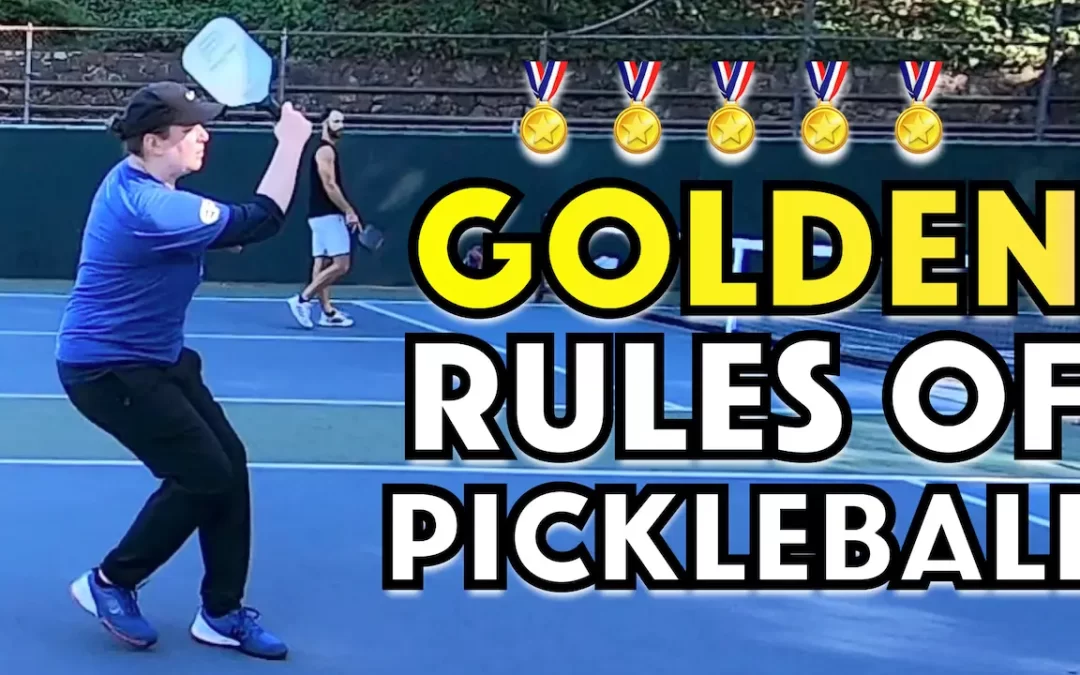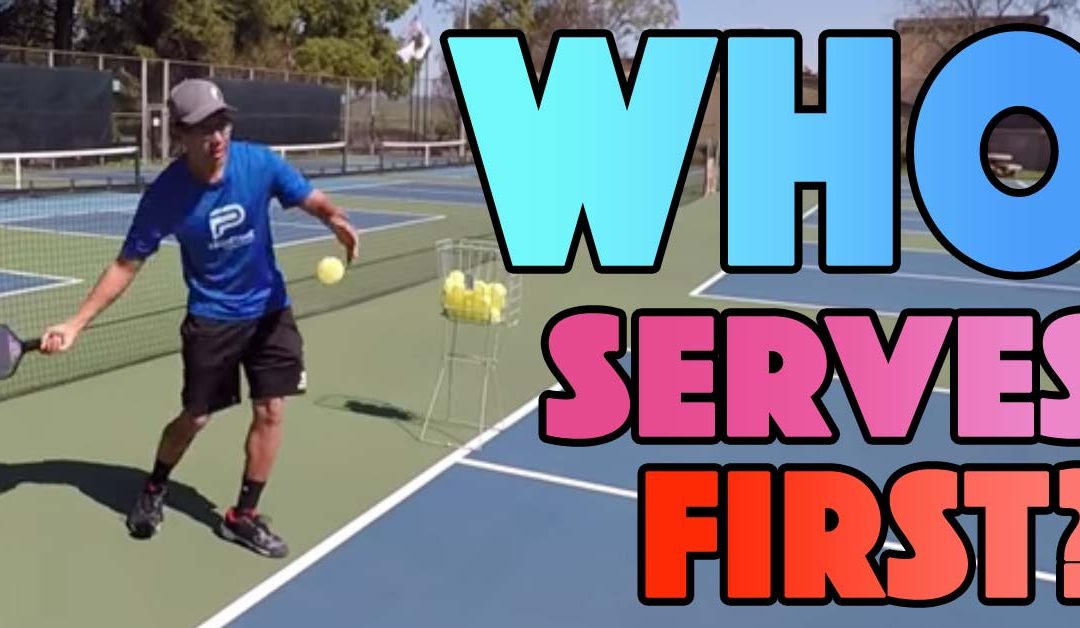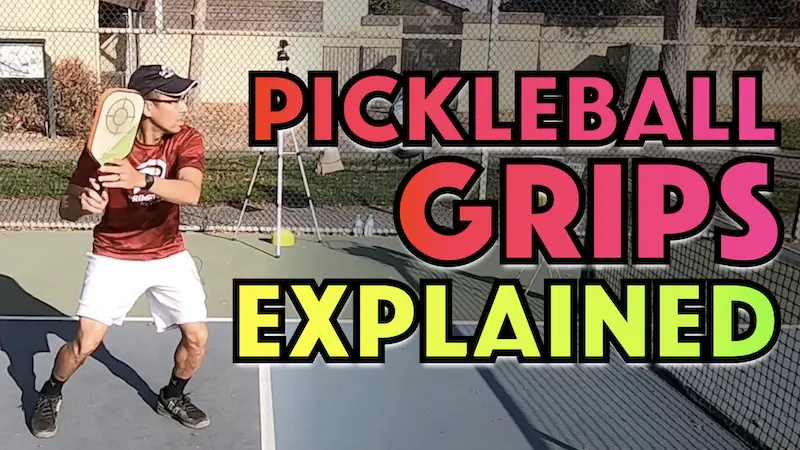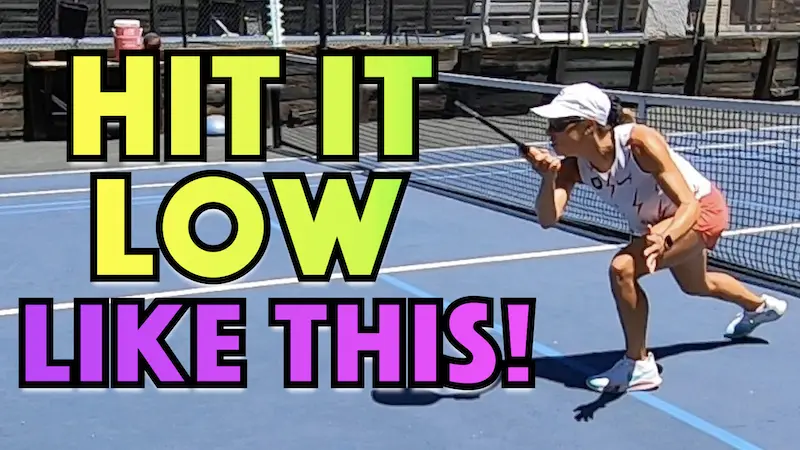Throughout your journey as a pickleball player you may find yourself sending your shot over to your opponent’s side higher than you would like more frequently than you would like.
That’s not ideal because the higher you send the ball over to the other side the more likely you are to be attacked especially if your opponents are further up in the court.
What separates a great pickleball player from the rest is their ability to keep the ball low at key moments and on demand. Keeping the ball low makes it more challenging for your opponent to make successful aggressive plays against you.
In this article, we look at some of the best ways of keeping the ball low in pickleball.
Why Keeping the Ball Low is Important in Pickleball
In pickleball, keeping the ball low reduces the chances of your opponent going on the offensive and stacking up points in their favor. That’s why this fundamental skill is an important one for both recreational and competetive players.
Coaches and partners alike will tell you that when you hit the ball too high, it’s called an attackable ball. Such a ball will often be put away by your opponent with an aggressive shot or a smash or at the very least, put you and your team on the defensive.
A general rule in pickleball is that the lower you keep the ball on your opponent’s side, the fewer attackable balls they will have. You will stay in the point longer and give yourself more chances to win the point. A great side benefit of hitting the ball low is that when you do that, your opponent is then forced to hit up and the chances of them handing you an attackable ball has increased.
Seven Tips to Keep the Ball Low in Pickleball
There are so many techniques that pickleball players use to keep the ball low.
Here are some of the top tips, that once mastered, are the vital components of what it takes to keep the ball low. Doing these things will keep the ball low in your opponents court making it hard for them to attack you while at the same time increasing the chances that you will receive an attackable ball in return.
1. Avoid Hitting Low to High Shots Hard
In order to keep the ball low in pickleball, you need to hit the ball at a certain angle with the right touch.
When you contact the ball at net height or above, it’s pretty straight forward what you have to do.
Assuming you’re going to send it back at higher speeds, which is usually what you will do on shots that you contact high, you have to keep the paddle face almost parallel to the net (slightly tilted up to combat gravity) at contact to keep the ball crossing low over the net.
But how do you keep it low on the other side when you yourself have received a low ball, and still have to clear the net with your shot. Well, you do so with low to high soft shots.
So what are low-to-high soft shots?
You must use a low-to-high swing motion in order to get a low ball up and over the net. There’s no way around that, it’s physics.
That becomes even more true the closer you get to the net. It gets more in your way the closer you are.
Depending on what shot you’re hitting (groundstroke vs. dink vs. drop etc…), your backswing can vary in take back height. You may take the paddle back high or low, whatever makes sense for the shot in question.
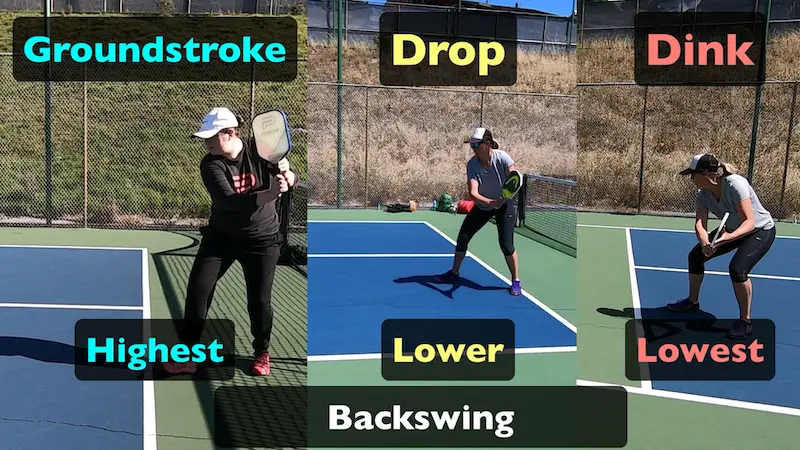
The point is that, regardless of your backswing height, you must, within your backswing motion, ultimately get your paddle under the ball and finish your motion higher than contact with the ball when you’re dealing with a low contact point.
Anytime you have to send the ball up so that it clears the net, there is a danger that if you send the ball too hard with a low to high motion, it will produce a high contact for your opponent and therefore be attackable.
At this point you’re probably in trouble on the very next shot that’s going to come your way.
A very good strategy to keep the ball low when you must use a low to high motion is to use a soft shot. You want to send it in such a way that it clears the net but is descending by the time it crosses the net and bounces before it gets to your opponent or at least forces them to have a low contact point even if they choose to volley it. That will prevent them from being able to hit a super aggressive attack.
Always be mindful when you have a low contact point that you must not hit it too hard. It’s almost always a good idea to use a soft shot in this situation such as a dink, drop or reset shot in order to keep your chances of winning the point high.
Focus on hitting with precise touch and just the right amount of arc to your shot so as to avoid the dreaded pop up, which is the same as sending the ball too high, that will be ruthlessly attacked by your opponents.
Your primary goal on these types of shots should be to setup neutral height or high-to-low shots for yourself on subsequent shots that come back from your opponents. At a minimum, you want to keep yourself from being attacked and stay in the point. You will do that by hitting low to high soft shots that bounce and stay low as we described.
2. Target Your Opponents Feet
As mentioned, it’s important to keep the ball low on your opponent’s side so as to stay away from producing high contact points for them that they can hit down on and attack you with.
This is one of the main objectives of pickleball: avoid being attacked.
But the truth is, it doesn’t matter if it’s high at some point on your opponent’s side, it only matter that they aren’t able to contact it high.
So more specifically rather than just saying to “keep it low”, the more important objective is to make them “contact low”.
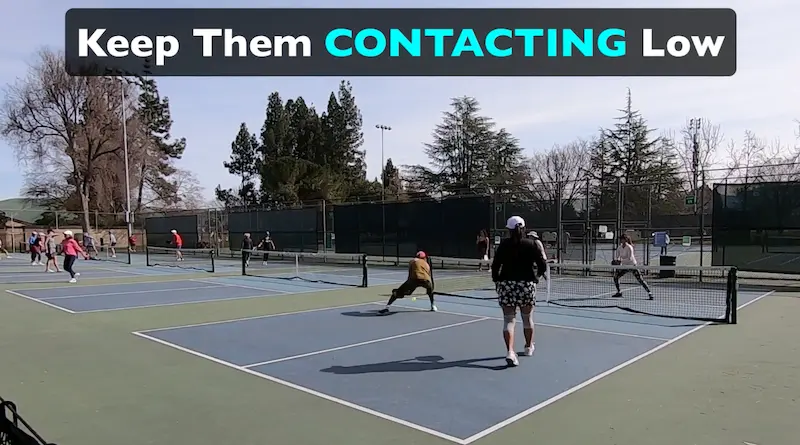
One of the best strategies to achieve this is to always aim at the feet of one of your opponents with a great majority of the shots you hit whether you hit them hard or soft. Or at least aim to hit it knee height or below as much as you can.
I also tend to call this “finding their shoelaces”.
So, even if you do have a low contact, if you can find a way to hit their shoelaces and force them into a low contact, even if it was technically high at some point on their side of the court before they’re able to hit it, then go ahead and do that.
This will be a more viable strategy when they are further back in the court rather than if they are up in the court.
The point is, you can hit it any which way you want and as hard as you want, and really as high as you want, as long as you are able force that low contact. Being sure to target their feet, whether you hit soft or hard, is a great way to do that.
3. Develop Quick Hands & Feet To Hit The Ball Early
Moving to the ball and striking it at its highest peak as soon as possible after it crosses the net will allow you to take the ball at the highest contact point available to you on that particular shot.
Although that’s not always possible for various reasons, such as for example, on a shot that will need to land in the kitchen because you can’t reach it out of the air, it will serve you greatly to maximize this objective.
Strive to get to your shots as quickly as possible to maximize the height of your contact with the ball.
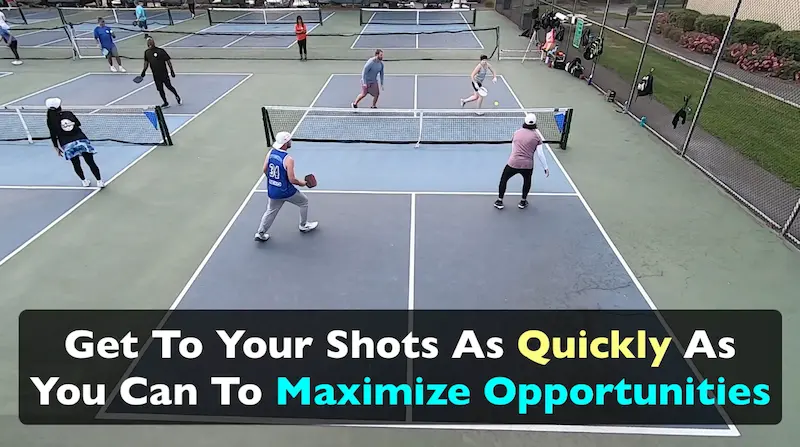
This sets up hitting the ball with a better angle to keep the ball low. Anytime you can make a contact above the net it becomes dramatically easier to keep it low on your opponent’s side. This is due to the possibility of hitting down into your opponent’s court. You don’t have to worry about clearing the net because your contact point is already above net height.
This also means that your shot will be affected less by external factors in the game, such as wind during outdoor play, and gravity.
Taking too long when hitting the ball has a number of downsides. For starters, the ball can start getting low as it loses momentum and your swing technique and accuracy may suffer as you may have to reach further down in order to make contact. Your backswing and follow through will likely have to be more compact as a result and your swing speed will be affected as well. It will be on the slower side.
Consequently, you may not be able to get under contact enough in order to produce the topspin that would be needed to hit a curved shot that would get up and clear the net and curve down once it has cleared the net. You are therefore at greater risk sending the ball too high over the net, giving your opponent the advantage of being able to get a high contact point and hit down and hard back at you.
Reaction time is very crucial in pickleball so try to be as quick as you can without losing control.
Pro Tip: if you are playing at the kitchen line, do not wait for the ball to bounce if your opponent hits a dink shot at your feet, strike the ball out of the air and as soon as possible!
4. Contact (Comfortably) In Front & Paddle Face Angle
You are most effective if you can hit the ball when it is out in front of you and not beside or behind you. Biomechanically, it’s just better. You can best transfer your energy into the ball when your contact is out in front of your body.
Contacting the ball in front has a range to it that frames an ideal “strike zone” and it’s in this area that you can best control your paddle and your paddle face angle.
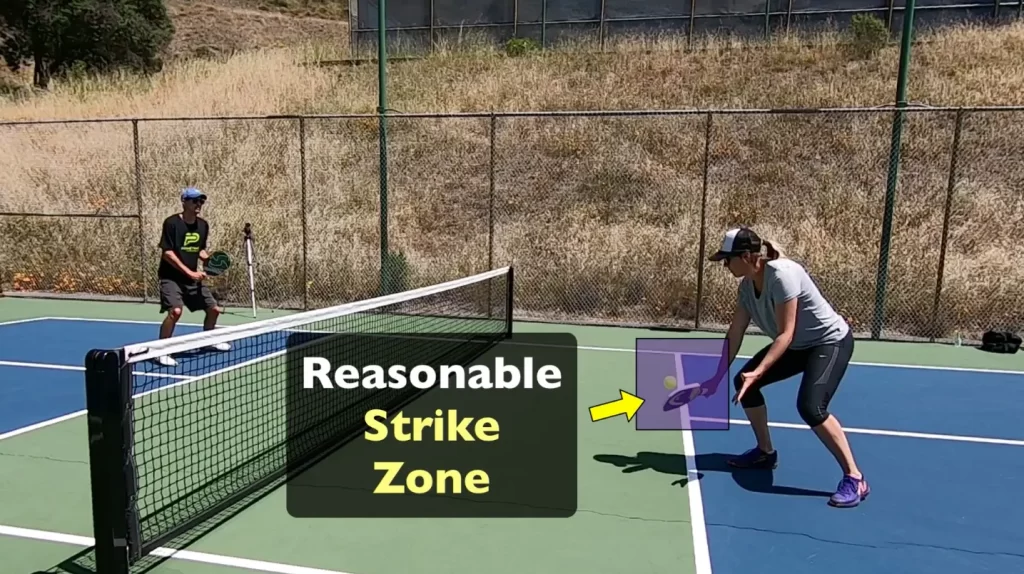
When you’re reaching or jammed you are more likely to have a too open or too closed contact which leads to you setting the ball high back over the net or down to the net or into the ground.
You will simply have a harder time with control when you’re outside of this “zone”.
It can still be an achievable shot when you’re jammed or stretched if you have a high level of skill but it’s certainly harder.
As mentioned earlier, you will very often want to be hitting soft shots on low contact points. For this you will need an open paddle face angle at contact.
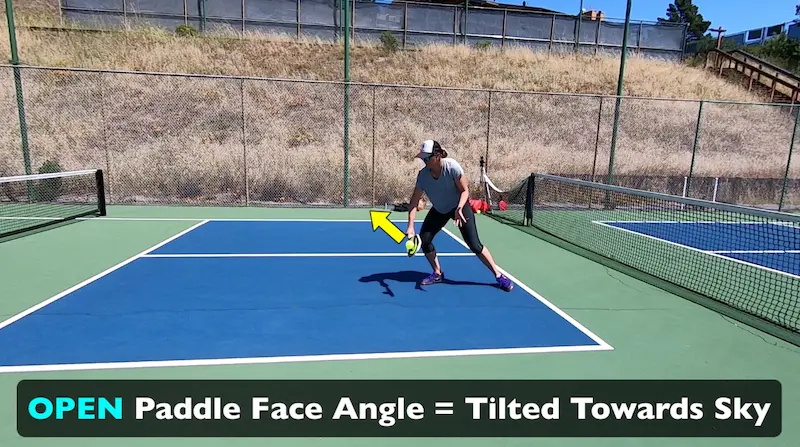
When you have a higher shot that you can drive with a more level trajectory and keep it low crossing the net, in such a way that will keep their contact point low, then go ahead and take that approach. You can hit it hard and aim lower to the net with a full swinging drive shot.
The key is to keep it low crossing the net which will often result in it being a low contact point for them or at the very least it will not be easily attackable because it’s hit quite hard and is low crossing the net which is generally not a shot that is easily attacked back.
When you have a very high contact point, like on the level of a high volley or overhead, you can have a downwards facing angle on your paddle face. This is often referred to as more of a closed paddle face.
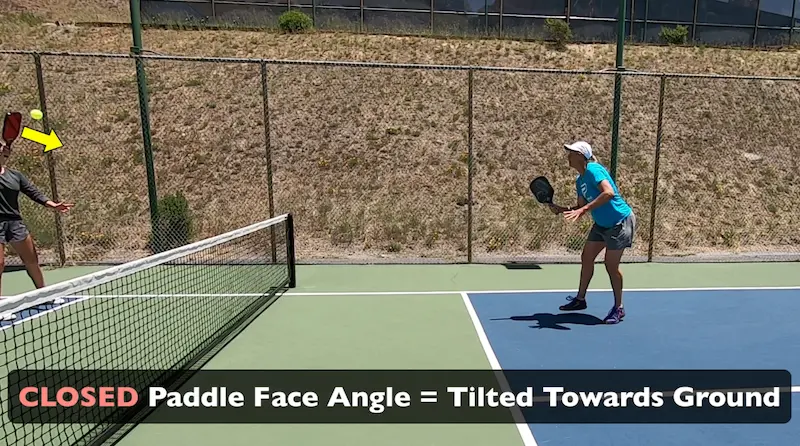
If you’re hitting a more level shot, then your paddle face will likely still be somewhat open at contact because you’re always fighting gravity to an extent but not nearly as open as on soft shots from low contact points.
Keeping the ball in front of you works hand-in-hand with striking the ball as early as you reasonably can when it come over the net.
Many players tend to hit the ball late, particularly on the forehand. Keep an eye on your wrist. If your wrist is straight at contact on the forehand the chances are your contact is beside you and that is inefficient. Your wrist should be laid back with wrinkles on the back of your wrist at contact. It will be in front when this is true. Many don’t find the feeling of a laid back wrist at contact comfortable at first but you MUST learn to get comfortable with it in order to have a strong forehand.
You will lose accuracy and power on your swing if your contact is anywhere but in front of your body.
You don’t want to be reaching out and fully extended nor do you want the contact to be just out in front of you by millimeters. You want to have a least a slight elbow bend at contact with a laid back wrist and you want the contact at least several inches out in front of your body.
5. Be Conscious of Your Grip Pressure
Your grip pressure on your pickleball paddle can affect how high or low you hit the ball.
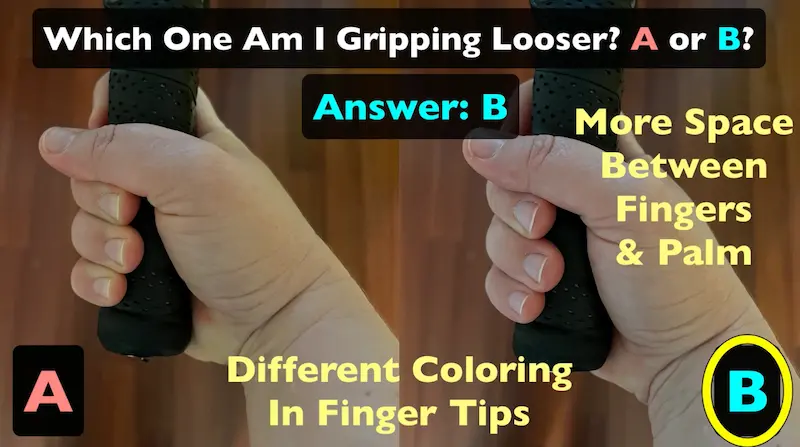
What many people are unaware of is that when you are playing a hard and fast game, such as when you’re in a hand speed battle at the net, it is easy to get distracted and subconsciously tighten the grip on the handle of your paddle.
This is because you may tend to tense up when you are under attack. This can cause a problem because the tighter your grip, the more the ball will rebound off your paddle.
Often this sends the ball harder and higher than you would like.
You’ll need a firmer grip if you’re counter-attacking but tightening your grip from fear or panic is never a good idea. It should be intentional and purposeful for the shot that you’re hitting.
When things get fast-paced at the court, breath and try to consciously loosen your death grip on the paddle.
This will allow your paddle to absorb some of the speed of the ball and as a result you can send it back softer and shorter in the court and reset the point instead of the situation getting beyond a point that you can’t control it.
Being aware of your grip on the paddle and keeping it loose when things get heated is not an easy technique to master and takes dedication and time. But, this is a key skill in pickleball and you need to take the time to understand how to hit shots soft and short in the court with a gentle arc, even when they’re coming fast as an attack.
Dealing with this shot this way is referred to as a reset and it’s a high level skill that will definitely up your game.
We recently did a video on this. You’ll want to check that out.
The benefits of the reset shot is that you will keep your opponent’s contact low even if they have hit hard at you and it’s your best chance of claiming a better court position more towards the non-volley zone line or preferably at the non-volley zone line and preventing repeated attacks.
6. Don’t Flick Your Wrist or Break Your Elbow
One of the main culprits of sending the ball unintentionally to high is excessive use of the wrist and/or elbow during your swing.
We see this all the time and it’s very important to eliminate most of any wrist or elbow motion you may have during contact.
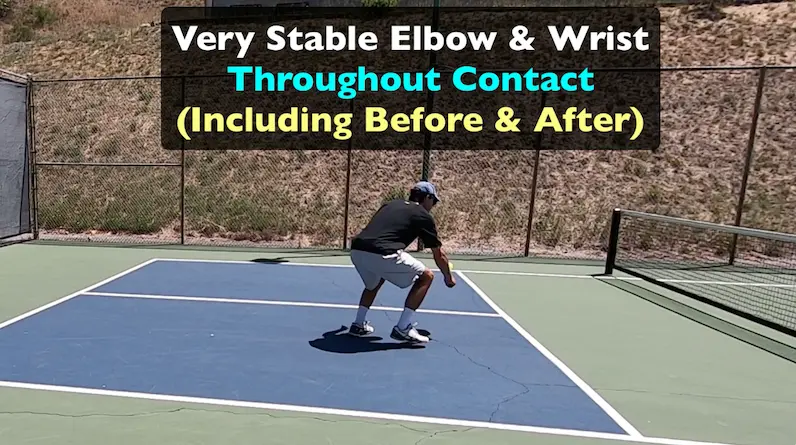
I’m more specifically referring to soft shots here. Full swing shots are a different story, though this still remains partially true even in those cases.
You’ll want to hit your shots swinging primarily from the shoulder and keep the wrist and elbow relatively stable with only minor motions.
Flicky motions that are abrupt with the wrist or elbow typically introduces instability into any pickleball motion and generally leads to a loss of control and accuracy.
Generate power using your legs and the rotation of your body and allow the main hinge to be your shoulder.
It will be much easier to keep the ball low when you have this squared away.
7. Learn Spin
Last, but certainly not least, one of the best things you can do to help you keep the ball low is to add spin to your game. There are two types of spin that you can use to keep the ball low.
Let’s start by covering how topspin can help you with that.
Topspin is an extremely effective tool in a pickleball player’s arsenal. It has the synergistic benefit of being an offensive shot and a defensive shot at the same time.
Offensive in the sense that when you have topspin on the ball it does complicate the timing of a clean contact for your opponent when they’re dealing with that shot. And, when a topspin shot hits the ground it does speed up and kicks towards your opponent which further complicates their timing.
In the defensive sense a shot hit with topspin can clear the net higher than other shots, such as a flat or underspin shot, which gives you more margin for error over the net.
The reason that is okay and it works out in the end is because the topspin causes the ball to curve downwards as it’s in flight. So if it’s hit well, by the time it reaches your opponent, it’s low.
The other spin that can be used under the right circumstances to keep the ball low is underspin. Underspin is also referred to as slice or backspin.
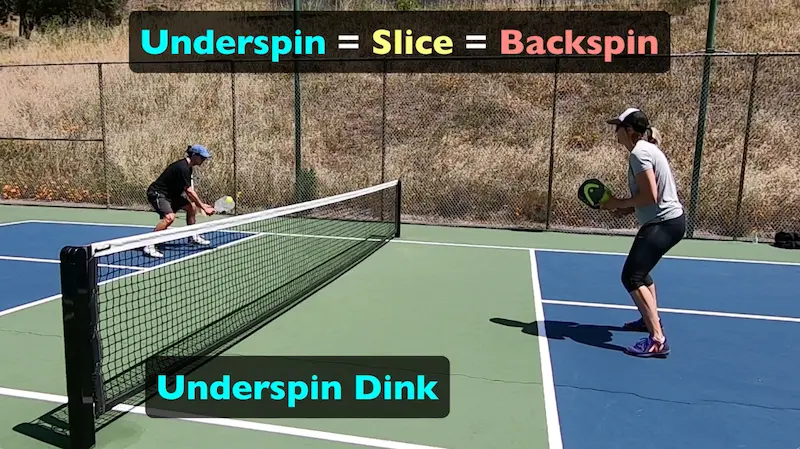
The point mentioned earlier about spin complicating the timing of a shot is still true here for underspin. Your opponent has to factor it in and can often misread and therefore misjudge how to play it.
A slice can be very beneficial because a shot that’s hit with a reasonable amount of slice will skid off the court and stay low thanks to the underspin on it.
For this reason, you’ll see slice used extensively in the dinking game at high levels and any other time when it’s important that the balls stay low throughout the entire flight of the ball.
That brings us to an important point. You do usually need to hit a slice shot relatively low crossing the net in order for it to skip and stay low on the other side. So that’s important to keep in mind. You don’t have the benefit of an extra margin of safety crossing the net as you do with topspin. You do however pick up the benefit of being able to hit slice when you yourself have a low contact and still keep it low on the other side by hitting slice back.
When the ball gets too low it is very difficult, and at times impossible, to get under it enough to hit topspin. You need to pick the right shot for the situation at hand.
Adding spins to your game is advanced so you don’t need to rush into learning it.
It’s critical to first master control of all your shots without spin before trying to introduce spin into your game.
Being able to keep the ball low on your opponent’s side is a vital skill to playing winning pickleball especially if you want to improve your play and move up to playing at higher levels.
Many players make the mistake of hitting too hard, too often. Then, once they play opponents of a higher skill it feels like they’ve run into a brick wall.
This happens because no matter how hard you hit it, your pace is just not overwhelming them as it would somewhat at a lower level and they’re getting lots of contacts at high levels, which they love, and will punish you with, because the pace is not phasing them.
It’s for this reason that you need to master the skill of keeping the ball low in pickleball and what we’ve covered today in this video/blog is how you’re going to accomplish that.
Final Thoughts
There are many techniques that can help keep the ball low in pickleball.
While it is not possible to remember all the mentioned steps, you can simply start with the ones that are easy to remember and implement during the game.
Over time, you will realize that your skills in keeping the ball low during the game will come naturally.
With pickleball increasingly becoming a mainstream sport, it has also become very competitive. The techniques highlighted above should help you play low balls which form a strong basis of winning matches.
Above all, regular practice at the court is what will improve your overall performance as a pickleball player. We hope you enjoyed these pickleball tips.
If you want to step up your game and develop a killer 3rd shot, then take a look here.

